How the Healthcare Industry Benefits From Platform Thinking
As the healthcare industry uncovers new ways to utilize health data to drive value-based care, digital platforms will bring applications together into a seamless and single-user experience for patients and providers.
Digital platforms are greater than the sum of the individual applications that underpin them, and why competitive advantage can’t simply be purchased with off-the shelf software solutions. In my last blog, I outlined the three key steps healthcare providers can take to migrate toward a digital health business model:
-
Define where you want to go
-
Put technology in its place
-
Pivot from applications, to platforms
Step three is so important that it needed its own blog post. For more details about the first two steps, catch up on my last blog post.
Platform thinking for your healthcare IT strategy
In healthcare, digital platforms provide a single point of entry, where a patient or a provider can access everything they want or need, regardless of the complexity or location of the underlying systems and data.
Platform thinking is the embodiment of digital transformation, leveraging an organization's technology and data to deliver new and innovative products and services.
How well an organization can integrate their unique applications and services into digital platforms will be what differentiates them from competitors.
Digital platforms also bring new complexities to the fold. Developers must stitch together data and functionality across what may be many siloed sources, and do so in real-time. A new provider digital platform may require ingesting a stream of medical sensor data, contrasting it with deep analytics insights from a data lake, and generating automated decisions and alerts, for example.
A platform perspective provides clarity as to why simply lifting and shifting existing applications to the cloud will not bring about the kind of transformation that’s required in healthcare. Lifting existing applications into the cloud is an investment in time and money that likely does more to enhance resumes, than position a healthcare organization for the needs of the future of healthcare delivery. The EHR system that runs in your data center will likely have the exact same features and limitations it does now, even after you lift-and-shift it to the cloud.

Platform thinking for healthcare data
Digital platforms demand architectures that free developers from the underlying application landscape complexities. Going to market quickly with new features, ones that deliver real-time data, and even swapping out services as your business evolves, are critical capabilities. They are also why digital platforms are almost always underpinned by an ODL (Operational Data Layer). An ODL can serve as a system of record for new features, as well as an integration layer between existing systems and third party services.
An ODL supporting a digital platform needs to work like a Swiss Army knife. Twenty years ago, nearly all of an organization's data interactions were executed against a relational database. Today’s software delivery teams need to support features beyond what relational offers, however, such as fuzzy-search, type-ahead, geospatial, graph, IoT, time-series, and even mobile capabilities. Choosing the right technology for your ODL can be overwhelming, but perhaps simplified by first listing out ideal features and capabilities it should support:
A digital platform ODL should support:
-
Relational
-
Document
-
Geospatial
-
Graph
-
Search
-
IoT
-
Time-series
-
Mobile
-
On-premise support
-
Cloud-hosted
-
Multi-cloud
Underpin digital platforms and ecosystems with an ODL
A MongoDB ODL serves as the best technology to underpin digital platforms and ecosystems. With the inherent flexibility of the document model, complex data from a variety of sources can be seamlessly integrated in real time. We believe that the digital platform ODL needs to be a general-purpose workhorse that can serve a wide variety of today's most demanding workloads.
When it comes to avoiding the pitfalls associated with so many cloud migration efforts, MongoDB makes it easier than ever to bring your data safely and securely to the cloud, or even multiple clouds. Plus, MongoDB is both HIPAA and GDPR compliant, and it offers rich, unparalleled features such as Client-Side Field Level Encryption, making it arguably the safest choice for your most sensitive healthcare data workloads.
We invite you to connect with us here, and let us partner with you as you build out the next generation of Healthcare digital platforms.
Additional Resources:
-
[Blog] The promise of public clouds for digital healthcare
-
[Case study] How Humana took HL7 FHIR to the cloud and drove better patient experiences
-
[Blog] FHIR Technology is Driving Healthcare’s Digital Revolution
-
[Blog] Drowning in data: why it’s time to end the healthcare data lake